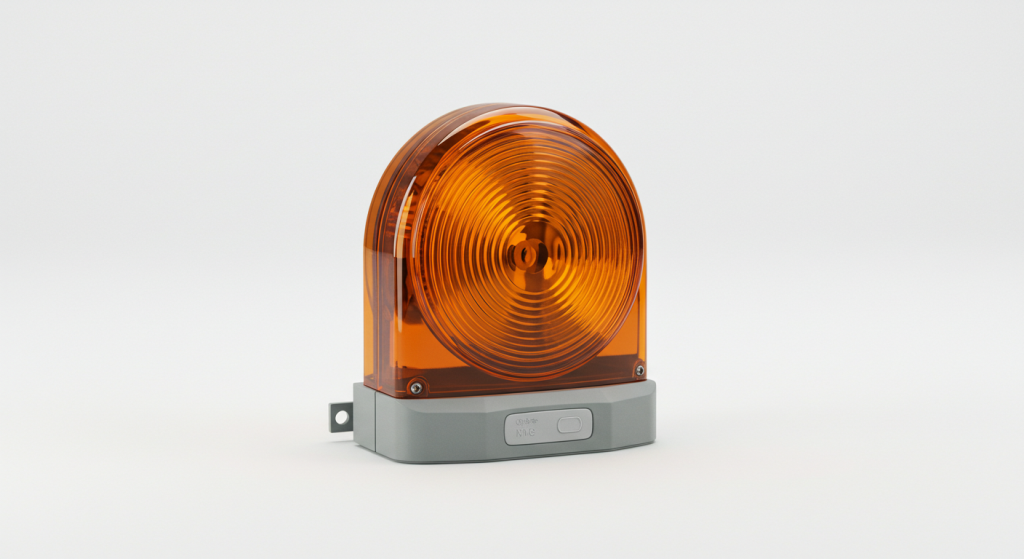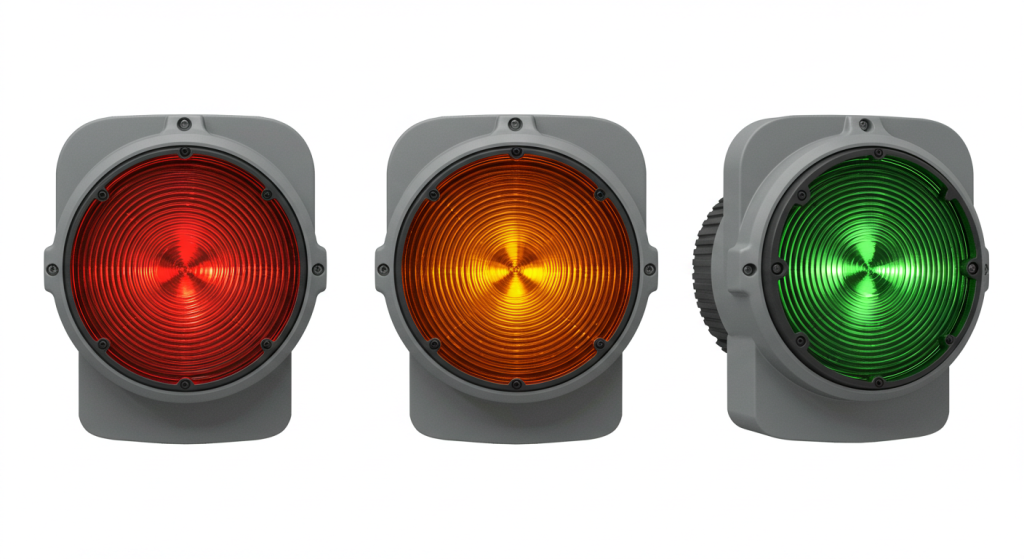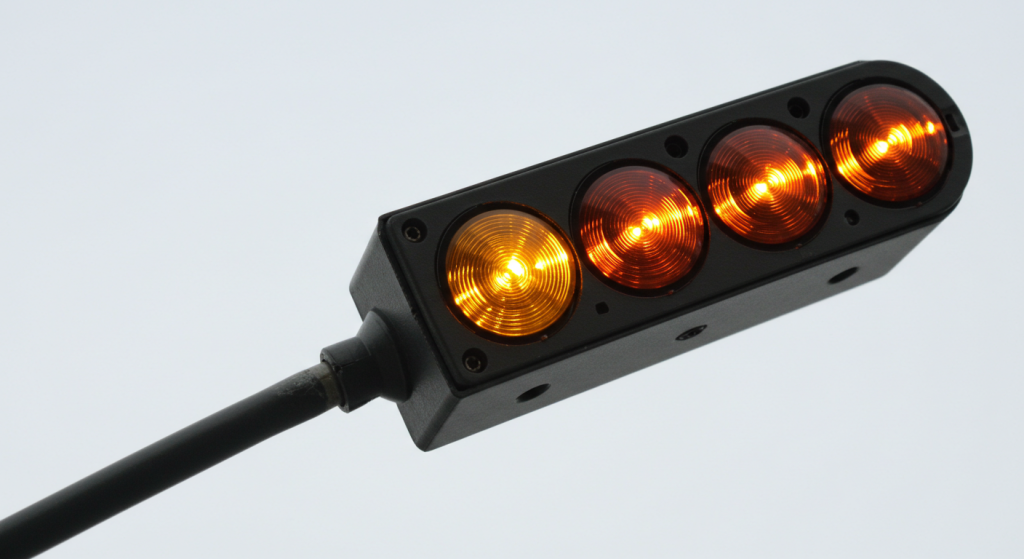Airports are bustling hubs of activity, serving as gateways to the world. As such, they require efficient and reliable lighting solutions to ensure safety, convenience, and aesthetics. Choosing the right Airport signal lights is crucial for creating a welcoming environment for travelers and staff alike. In this article, we will delve into the key factors to consider when selecting Airport runway lights, providing you with a comprehensive guide to illuminate the skies.

- Understanding the Requirements:
Before delving into the specifics of clearance bar lights, it is essential to understand the unique requirements of an airport environment. Factors such as high traffic volume, varying weather conditions, and diverse operational areas must be taken into account. Let’s explore some of the primary considerations:
a. Safety: Airport signal lights must prioritize safety by providing adequate visibility and preventing accidents. This includes illuminating runways, taxiways, aprons, and terminal buildings.
b. Energy Efficiency: With the increasing focus on sustainability, choosing energy-efficient lighting solutions is crucial. LED technology has emerged as a popular choice due to its low energy consumption and long lifespan.
c. Durability: Airport signal lights systems must withstand harsh weather conditions, extreme temperatures, and constant use. Durable materials and robust construction are essential for ensuring longevity.
- Types of Airport signal lights:
There are various types of lighting solutions available for airports, each serving different purposes. Let’s explore some of the commonly used options:
a. Runway Lighting: Runway lighting systems are designed to provide visibility for pilots during takeoff and landing. They include runway edge lights, threshold lights, and runway centerline lights.
b. Taxiway Lighting: Taxiway lighting ensures safe navigation for aircraft on the ground. It includes taxiway centerline lights, edge lights, and runway exit lights.
c. Terminal Lighting: Terminal lighting systems illuminate the terminal buildings, providing a welcoming and comfortable environment for passengers. These systems may include wall washers, cove lights, and underfoot lighting.

- Key Factors to Consider When Choosing Airport signal lights:
When selecting Airport signal lights, several factors should be considered to ensure optimal performance and satisfaction:
a. Light Output: The light output of the lighting fixtures should be sufficient to meet the specific requirements of the airport. Higher light output is generally required for areas with high traffic volume.
b. Color Temperature: The color temperature of the lighting fixtures can impact the overall ambiance of the airport. Warm white lighting is often preferred for creating a welcoming atmosphere, while cool white lighting is suitable for areas requiring higher visibility.
c. Control Systems: Advanced control systems can optimize energy consumption and enhance the lighting experience. Features such as dimming capabilities, daylight harvesting, and occupancy sensors can be integrated into the lighting system.
- Case Study: Successful Airport signal lights Implementation
Let’s take a look at a real-world example of a successful Airport signal lights implementation:
The XYZ Airport, located in a bustling metropolis, recently upgraded its lighting system to improve energy efficiency and enhance the passenger experience. By replacing outdated fluorescent lighting with energy-efficient LED fixtures, the airport achieved significant energy savings. The new lighting system also provided better visibility, reducing the risk of accidents. Additionally, the airport implemented smart control systems, allowing for precise control of lighting levels based on occupancy and natural light conditions.
- Types of Airport signal lights Systems:
Before delving into the buying process, it’s important to understand the different types of Airport signal lights systems:
a. Runway Lighting: These lights guide pilots during takeoff and landing, enhancing visibility on the runway.
b. Taxiway Lighting: These lights assist pilots in navigating the airport’s taxiways and runway intersections.
c. PAPI (Precision Approach Path Indicator): These lights indicate the glide slope for pilots during final approach.
d. Obstacle Lighting: These lights illuminate obstructions around the airport to prevent collisions.

- Factors to Consider When Buying Airport signal lights:
a. Quality: Opt for high-quality lighting systems that meet international standards and ensure long-term reliability.
b. Cost: Compare prices from different suppliers to find the most cost-effective solution without compromising on quality.
c. Customization: Choose a supplier that offers customization options to meet specific airport requirements.
d. Warranty and Support: Ensure that the supplier provides comprehensive warranty coverage and excellent customer support. - Case Study: A Successful Airport signal lights Project
Let’s take a look at a real-life example of a successful Airport signal lights project:
The XYZ Airport, located in a major city, required a comprehensive lighting solution to enhance safety and efficiency. After thorough research, the airport’s management team selected a reputable supplier that offered a wide range of products, including runway, taxiway, and obstacle lighting.
The supplier provided a customized solution that included energy-efficient LED lights, which reduced the airport’s energy consumption significantly. Additionally, the supplier offered excellent customer support and warranty coverage, ensuring that the airport’s lighting system remained in optimal condition.
- Top Airport signal lights Suppliers:
Here are some of the top Airport signal lights suppliers that have a proven track record in the industry:
a. Supplier A: Specializes in high-quality runway and taxiway lighting systems, with a focus on energy efficiency.
b. Supplier B: Offers a wide range of lighting solutions, including PAPI and obstacle lighting, with customization options.
c. Supplier C: Known for its innovative LED lighting technology and excellent customer support.
- Understanding the Types of Airport signal lights:
1.1 Runway Lighting:
Runway lighting is vital for pilots to safely navigate the runway during low visibility conditions. It includes:
a. Runway edge lights
b. Runway centerline lights
c. Runway threshold lights
1.2 Taxiway Lighting:
Taxiway lighting guides aircraft on the ground, ensuring safe movement within the airport. It includes:
a. Taxiway centerline lights
b. Taxiway edge lights
c. Taxiway exit lights
1.3 PAPI (Precision Approach Path Indicator) Lighting:
PAPI lighting assists pilots in determining the aircraft’s approach path and runway alignment during instrument approaches. It includes:
a. PAPI lights
b. PAPI indicator lights
1.4 General Lighting:
General lighting provides illumination for various areas within the airport, such as terminal buildings, parking garages, and aprons.
- Factors to Consider When Purchasing Airport signal lights:
2.1 Performance:
Ensure that the lighting products meet the international standards for Airport signal lights, such as ICAO (International Civil Aviation Organization) and FAA (Federal Aviation Administration) requirements.
2.2 Durability:
Select lighting solutions that are designed to withstand harsh environmental conditions, such as extreme temperatures, humidity, and salt spray.
2.3 Energy Efficiency:
Opt for energy-efficient lighting options to reduce operational costs and minimize the environmental impact.
2.4 Installation and Maintenance:
Consider the ease of installation and maintenance of the lighting products, as this can affect the overall cost and operational efficiency.
2.5 Compatibility:
Ensure that the lighting products are compatible with your existing infrastructure and can be easily integrated.
- Case Study: Implementing an Energy-Efficient Airport signal lights Solution
ABC Airport, a major hub in Europe, was looking to upgrade its runway lighting system to enhance safety and reduce energy consumption. After thorough research, the airport decided to purchase energy-efficient LED lighting solutions from a reputable supplier.
The supplier provided a comprehensive package that included:
a. LED runway edge lights
b. LED runway centerline lights
c. LED taxiway centerline lights
d. Energy-efficient control systems
After the installation, the airport experienced several benefits:
a. Reduced energy consumption by 60%
b. Enhanced visibility and safety for pilots
c. Extended lifespan of the lighting fixtures
d. Lower maintenance costs
I. Determining the Amount of Airport signal lights Required
- Lighting Design Criteria:
The amount of Airport signal lights required is determined by several factors, including:
a. Runway length and width
b. Runway surface material
c. Weather conditions
d. Air traffic density
e. Safety regulations
- Illuminance Levels:
Illuminance levels are measured in lux (lx) and vary depending on the application. For example, a minimum of 200 lx is required for runway visual range (RVR) and approach lighting systems, while higher levels may be necessary for critical areas such as taxiways and aprons.
II. Types of Airport signal lights Products
- Runway Lighting:
a. Runway edge lights: These lights mark the edges of the runway, providing visual guidance for pilots.
b. Runway centerline lights: These lights align pilots with the centerline of the runway.
c. PAPI (Precision Approach Path Indicator) lights: These lights help pilots determine the correct glide slope during approach. - Taxiway Lighting:
a. Taxiway edge lights: These lights outline the taxiways, aiding pilots in navigating the airport.
b. Taxiway centerline lights: These lights guide pilots along the taxiways. - Apron Lighting:
a. Apron edge lights: These lights mark the boundaries of the apron area.
b. Apron lighting: These lights illuminate the apron for ground operations.
III. Case Studies
- Case Study 1: International Airport A
This airport replaced its outdated lighting system with a modern, energy-efficient solution. The new system provided improved visibility, reduced maintenance costs, and enhanced safety. The amount of lighting required was optimized based on the airport’s specific operational needs and safety regulations. - Case Study 2: Regional Airport B
This regional airport faced challenges with its existing lighting system, which struggled to provide adequate illumination during inclement weather. After a thorough analysis, the airport installed a new lighting system with advanced features, such as adaptive controls and weatherproof components. The new system significantly improved visibility and safety, ensuring smooth operations even during adverse weather conditions.
I. Factors Influencing Airport Lighting Prices
- System Complexity:
The complexity of the airport lighting system significantly impacts its price. Systems with advanced features, such as adaptive lighting and automated control, tend to be more expensive than basic ones. For instance, a simple lighting system for a small airport may cost around 50,000, whereas a complex system for a major international airport could exceed 10 million. - Size and Scope of the Project:
The size and scope of the project directly influence the cost. Larger airports require more extensive lighting coverage, which can increase the overall price. Additionally, additional features like LED lighting, energy-efficient solutions, and smart control systems can also contribute to higher costs. - Installation and Maintenance:
The installation and maintenance costs are often overlooked but play a significant role in the overall price. Proper installation requires skilled labor and specialized equipment, which can add to the cost. Additionally, maintenance costs, including repairs and replacements, should be considered in the long-term perspective.
II. Product Details: What to Consider
- Lighting Technology:
The choice of lighting technology significantly affects the cost and performance of airport lighting systems. Traditional sodium and mercury vapor lamps are less expensive but have lower energy efficiency and shorter lifespans. In contrast, LED lighting offers higher efficiency, longer lifespans, and lower maintenance costs. For instance, a LED lighting system could cost 20-30% more upfront but save money in the long run due to reduced energy consumption and maintenance. - Control Systems:
Advanced control systems can optimize lighting performance, reducing energy consumption and costs. Smart control systems, such as dimming and scheduling, can adjust lighting levels based on time, weather conditions, and other factors. While these systems may be more expensive, they can provide significant long-term savings. - Customization:
Customized lighting solutions tailored to specific airport requirements can impact the price. This includes factors like the color of the lighting, the intensity, and the specific areas requiring illumination. While customization can increase costs, it ensures that the lighting system meets the unique needs of the airport.
III. Case Study: A Major International Airport
Let’s consider a major international airport that decided to upgrade its lighting system. Initially, the airport had a traditional sodium vapor lighting system, which required frequent maintenance and high energy consumption. After evaluating various options, the airport decided to invest in a LED lighting system with smart control capabilities.
The new system included the following features:
- LED lighting technology for higher efficiency and longer lifespan.
- Smart control systems to optimize lighting levels based on time and weather conditions.
- Customized solutions to address specific areas requiring illumination.
The total cost of the project, including installation and maintenance, was approximately $5 million. However, the airport expected to see significant savings in energy consumption and maintenance costs over the long term.
I. Understanding Airport Lighting Systems:
- Types of Airport Lighting:
a. Runway lighting: Essential for runway visibility and navigation.
b. Taxiway lighting: Facilitates movement of aircraft on the ground.
c. Paved area lighting: Illuminates parking areas and taxiways.
d. Approach lighting: Guides pilots during landing and takeoff. - Lighting Technologies:
a. Incandescent lighting: Traditional and widely used but less energy-efficient.
b. Fluorescent lighting: More energy-efficient than incandescent but has a shorter lifespan.
c. LED lighting: The most energy-efficient and durable option available.
II. Factors Influencing Airport Lighting Costs:
- Installation Costs:
a. Design and engineering: Detailed planning and design of the lighting system.
b. Labor: Skilled labor required for installation and maintenance.
c. Equipment: Quality of lighting fixtures, cabling, and other materials. - Maintenance Costs:
a. Regular inspections: Ensuring the lighting system operates efficiently.
b. Replacement parts: Cost of replacing faulty or damaged components.
c. Energy consumption: The cost of electricity required to power the lighting system.
III. Case Study: XYZ Airport Lighting Upgrade
- Background:
XYZ Airport, a medium-sized airport in the United States, aimed to improve its lighting system to enhance safety and operational efficiency. - Solution:
The airport decided to upgrade its existing incandescent lighting system to LED technology. The project involved replacing runway, taxiway, and paved area lighting fixtures. - Results:
a. Reduced energy consumption: LED lighting reduced energy consumption by 60%.
b. Lower maintenance costs: LED fixtures have a longer lifespan, reducing the need for frequent replacements.
c. Improved safety: Enhanced visibility improved the overall safety of the airport.
IV. Product Details: LED Airport Lighting Fixtures
- LED technology: Utilizes light-emitting diodes (LEDs) for energy-efficient and durable lighting.
- Color temperature: Available in various color temperatures, ranging from warm to cool white.
- Beam distribution: Customizable beam patterns to suit specific lighting requirements.
- Weather resistance: Designed to withstand harsh weather conditions, including rain, snow, and extreme temperatures.
Choosing the right Airport signal lights is a critical decision that can impact safety, energy efficiency, and overall ambiance. By considering the specific requirements of your airport, exploring various lighting options, and evaluating key factors such as light output, color temperature, and control systems, you can create a well-lit and welcoming environment for travelers and staff. Remember to seek professional advice and consider successful case studies to ensure a successful Airport signal lights implementation.